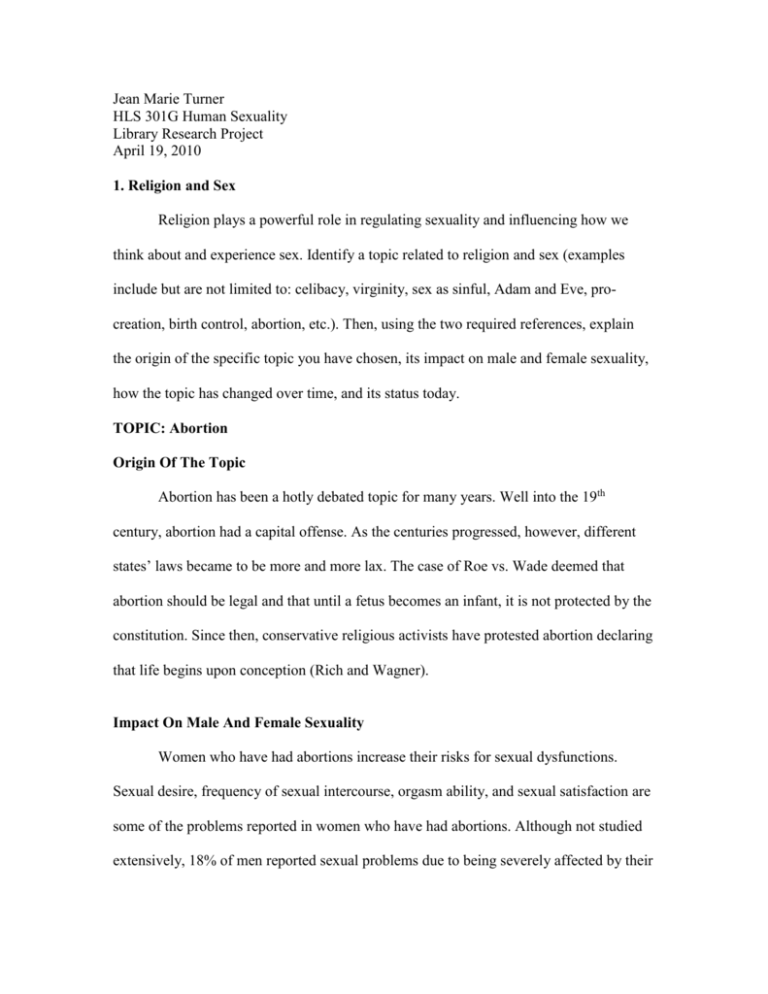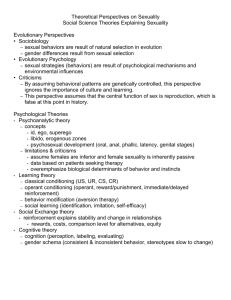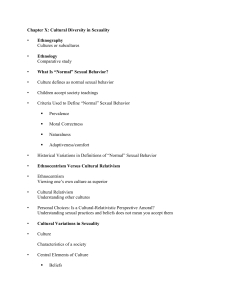
Jean Marie Turner
HLS 301G Human Sexuality
Library Research Project
April 19, 2010
1. Religion and Sex
Religion plays a powerful role in regulating sexuality and influencing how we
think about and experience sex. Identify a topic related to religion and sex (examples
include but are not limited to: celibacy, virginity, sex as sinful, Adam and Eve, procreation, birth control, abortion, etc.). Then, using the two required references, explain
the origin of the specific topic you have chosen, its impact on male and female sexuality,
how the topic has changed over time, and its status today.
TOPIC: Abortion
Origin Of The Topic
Abortion has been a hotly debated topic for many years. Well into the 19th
century, abortion had a capital offense. As the centuries progressed, however, different
states’ laws became to be more and more lax. The case of Roe vs. Wade deemed that
abortion should be legal and that until a fetus becomes an infant, it is not protected by the
constitution. Since then, conservative religious activists have protested abortion declaring
that life begins upon conception (Rich and Wagner).
Impact On Male And Female Sexuality
Women who have had abortions increase their risks for sexual dysfunctions.
Sexual desire, frequency of sexual intercourse, orgasm ability, and sexual satisfaction are
some of the problems reported in women who have had abortions. Although not studied
extensively, 18% of men reported sexual problems due to being severely affected by their
partner’s abortion (Coleman).
How The Topic Has Changed Over Time
The United States outlawed abortion in the 1820’s out of concern for women’s
health, although illegal abortions continued to be performed especially among
impoverished women. As abortion procedures began to improve, abortion laws became
more lax, allowing women to have abortions when the mother’s life is in danger. Norma
McCorvey, who used the name of Jane Roe, claimed that the government was
encroaching her rights by making her get an abortion in a different state than where she
lived in the case of Roe vs. Wade, which made abortion illegal and declared that a fetus
was not protected by the constitution. Thus, the debate changed from whether or not
abortion is healthy for a woman, but whether or not a fetus has rights (Rich and Wagner).
Status Today
Due to increased contraceptive methods, the number of abortions has decreased
recently. Health risks are decreased the earlier in the pregnancy that the procedure is
executed. The Bush administration banned late-term abortion, even if the woman’s health
is at risk, in 2003. Many pro-choice activists feel that this will be a step towards banning
abortions altogether again. Pro-life activists continue to challenge the decision of Roe vs.
Wade in hopes to overturn current abortion laws (Rich and Wagner).
Additional Information
Many people have had post-abortion regret or guilt. Seventy-five percent of
women have reported that they felt they had lost more than just a pregnancy. Abortions
have also been known to affect women’s mental health. Twenty percent of women had
pronounced psychological difficulties (Coleman).
References:
1. Rich, A., and Wagner, G. Abortion: An Overview. Retrieved April 20, 2010, from
Points of View Reference Center:
http://web.ebscohost.com/pov/detail?vid=4&hid=15&sid=68b4154e-551f-4f9aa695e2ee5afa84e1%40sessionmgr13&bdata=JnNpdGU9cG92LWxpdmU%3d#db=pw
h&AN=22826417
2. Coleman, P.K. The Decline of Partner Relationships in the Aftermath of Abortion.
Retrieved April 20, 2010, from lifeissues.net: http://www.lifeissues.net/main.php
2. International Human Sexuality Issues
Different countries sometimes have very different beliefs and practices related to
human sexuality. Identify a topic related to international human sexuality issues
(examples include but are not limited to: female genital mutilation, prostitution, gender
roles and expectations, female vs. male offspring, virginity, fertility, birth control, etc.).
Then, using the two required references, explain the origin of the specific topic you have
chosen, its impact on male and female sexuality, how the topic has changed over time,
and its status today.
TOPIC: Female Genital Mutilation
Origin Of The Topic
Although the exact origins are unknown, female genital mutilation is believed to
have originated in Africa as early as the 5th Century B.C. Other places that have had
histories with this procedure include ancient Rome, Egypt, Arabia, and Tsarist Russia. It
was also used in Victorian Era Europe as a remedy for some psychological impairments
in women and the prevention of female masturbation (Little).
Impact On Male And Female Sexuality
In some cultures, the removal of the clitoris empowers women. Men know very
little about the procedure, and it is the mothers who make sure the procedure is done on
their daughters. An uncircumcised woman is looked down upon and is considered
unfeminine. Cultures who practice female circumcision uphold purity and sexual restraint
before marriage. A woman who can resist her husband’s sexual advances on their
wedding night is considered powerful and strong. The clitoris is considered an ugly, dirty
thing that never stops growing (Little).
How The Topic Has Changed Over Time
As early as what some people believe to be 5th Century B.C. (Little), female
genital mutilation originated as a right of passage for females and as away to keep
women sexually pure before marriage. Later on during the Victorian era in the U.S. and
Europe, it was use to prevent female masturbation and as a treatment for psychological
dysfunctions in women. As further mentioned in the following paragraph, many
organizations today have declared this procedure unsafe and are discouraging the
practice.
Status Today
Female Genital mutilation is still practiced in twenty-five countries in central
Africa, and about 130 million women have undergone this procedure (Brunner), and also
in Middle East countries including the Oman, Yemen, the United Arab Emirates and
Asian countries including Indonesia, Malaysia, Sri Lanka, and India (Little). Many
organizations, including the United Nations Children's Fund, the United Nations
Population Fund, and the World Health Organization, have together stated that female
genital mutilation “causes unacceptable harm and issued a call for the elimination of this
practice worldwide (Little).”
Additional Information
There are three types of female genital mutilation. The first type is sunna, or
traditional, which involves excision of the prepuce with or without excision of part or all
of the clitoris. The second is clidoridectomy, which involves excision of the prepuce and
clitoris together with partial or total excision of the labia minora. The final type is
infibulation or Pharaonic circumcision, which is the excision of part or all of the external
genitalia and suturing to narrow the vaginal introitus (Little).
References:
1. Little, C.M. Female Genital Circumcision: Medical and Cultural Considerations
.Retrieved April 26, 2010, from BNET:
http://findarticles.com/p/articles/mi_m0MJU/is_1_10/ai_102025141/pg_2/?tag=c
ontent;col
2. Brunner, B. The Abolition of Female Genital Mutilation. Retrieved April 26, 2010,
from infoplease: http://www.infoplease.com/ipa/A0001524.html
3. Ethical Issues and Human Sexuality
There are numerous moral and ethical issues related to human sexuality that
collectively define our boundaries and limitations both as individuals and as a society.
Identify a topic related to ethical and/or moral issues with human sexuality (examples
include but are not limited to: sexual behaviors, sexual orientation, atypical sexual
behavior, sexual coercion, sex for sale, abortion, etc.). Then, using the two required
references, explain the origin of the specific topic you have chosen, its impact on male
and female sexuality, how the topic has changed over time, and its status today.
TOPIC: Sexual Orientation
Origin Of The Topic
Most scientists agree that many factors combined create one’s sexual orientation,
including environmental, emotional, hormonal, and biological factors (WebMD).
Contrary to popular belief, one is not more likely to be homosexual due to smothering
maternal love, sexual abuse, and distant fathers (Myers).
Impact On Male And Female Sexuality
Women have a more variable orientation than men (Myers). They are more likely
to be bisexual or to vary in their attractions to men and other women. A higher sex drive
in men is linked to higher attractions to women; whereas in women, a higher sex drive is
linked to attractions to both men and women (Myers).
How The Topic Has Changed Over Time
Homosexuality was considered a sin during the Middle Ages, a crime in the 17th
century, and a mental illness in the 19th and early 20th centuries.
Status Today
Today, scientists agree that it is a combination of environmental and biological
factors that contribute to sexual orientation. While this has contributed to more
acceptance of homosexuals, many gay-rights activists fear that this will lead fetal testing
and abortions if infants were not sexually oriented the way the parents wished (Myers).
References:
1. Sexual Orientation. Retrieved April 26, 2010, from WebMD:
http://www.webmd.com/sex-relationships/guide/sexual-orientation
2. Myers, D. G. (2010), Psychology, 9th edition. New York: Worth Publishers. Retrieved
April 26, 2010, from David G. Myers’ website:
http://www.davidmyers.org/davidmyers/assets/Sex-Orient-9e.pdf
4. Multicultural Human Sexuality Issues
Different cultures sometimes have very different beliefs and practices related to
human sexuality. Identify a topic related to multicultural human sexuality issues
(examples include but are not limited to: multicultural relationships, gender roles and
expectations, virginity, fertility, birth control, socioeconomic status, abortion, etc.). Then,
using the two required references, explain the origin of the specific topic you have
chosen, its impact on male and female sexuality, how the topic has changed over time,
and its status today.
TOPIC: Multicultural Relationships
Origin Of The Topic
Interracial marriages became legal in the United States in 1967 (Duru). This
coupled with an increase in immigration has lead to an increase in multicultural
relationships.
How The Topic Has Changed Over Time
Up until 1967, interracial marriage had been illegal. For the next forty years,
interracial relationships were met with much prejudice, but they became more and more
acceptable due to the increase of immigration and the favorable portrayal of interracial
relationships in the media (Duru)
Status Today
There are about two million interracial marriages in the US today (Duru).
Increased immigration has broadened the dating pool for many individuals. Celebrities
such as Miriah Carey and Tiger Woods, both multiracial individuals, have taken the
stigma away from interracial relationships (Duru)
References:
1. Duru, F. The Cause of the Escalating Trend of Multicultural Relationships. Retrieved
April 27, 2010, from Buzzle.com: http://www.buzzle.com/editorials/3-29-200692183.asp
2. Coleman, P.K. The Decline of Partner Relationships in the Aftermath of Abortion.
Retrieved April 20, 2010, from lifeissues.net: http://www.lifeissues.net/main.php
5. Journal Article Review
Article Reviewed: Impact of Recreational Sex on Sexual Satisfaction and Leisure
Satisfaction
This article was written on the basis that college students participate in sex purely
for leisure purposes. The researchers wanted to determine if recreational sex affected
sexual and leisure satisfaction. They presented a questionnaire to determine this to a
sample of undergraduate students at a Southeastern university. The conclusion was that
these findings could be valuable in reducing high-risk sexual behaviors.
This article pertains to human sexuality because it shows how much sexuality has
changed in our cultural. While we once viewed sexuality in a religious context that only
permitted sex for procreation purposes only, we now view sex as a leisure activity.
People are becoming more educated and less influenced by religious leaders and are
better equipped with knowledge in regards to safe sex and have more access to different
forms of birth control.
References:
1. Marx, A., Penhollow, T., and Young, M. Impact of Recreational Sex on Sexual
Satisfaction and Leisure Satisfaction. Retrieved April 28, 2010 from the
Electronic Journal of Human Sexuality:
http://www.ejhs.org/volume13/recreationalsex.htm
2. Whipps, H. A Brief History of Human Sex. Retrieved April 28, 2010, from Live
Science: http://www.livescience.com/health/060727_sex_history.html










